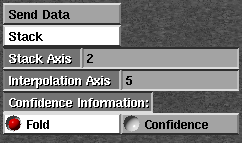|
Infill90
Figure 2 Control panel for the Infill90 module. |  |
Figure 2 shows the user interface for this module.
|
Infill90
Figure 2 Control panel for the Infill90 module. |  |
The Stack boolean widget, allows the user to specify if the data should be stacked according to the stacking axis indicated by the Stack Axis type-in widget (reducing data volume) or sent in its entirety down stream. The Interpolate Axis widget allows the user to specify the dimension to perform linear interpolation on. The choice widgets Fold and Confidence, allows the users to select the type of reliability information that should be generated. If Fold is selected, the reliability information will based on information obtained by stacking along the Stack Axis. The number of traces corresponding to a given bin (where bin is defined as the output trace obtained by stacking) is normalized by maximum number of traces (resulting float values between 0. and 1.). If Confidence is selected, the output will represent how close each trace is to known values. Values equal to 1 are associated to known traces and values less than 1 are associated to interpolated traces. The reliability information value associate to interpolated traces close to known traces will be higher than those associated to interpolate traces far from known traces. In both cases, values close to 1 indicate reliable data. Finally, once the user has finished with the parameter specification, the Send Data one-shot widget should be selected to execute the module and pass the output information to downstream modules.